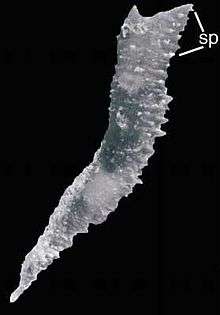Conchicolites
| Conchicolites Temporal range: Late Ordovician–Devonian[1] | |
|---|---|
 | |
| Conchicolites sp. overview of the rings with spines, Lilla Karlsö, Sweden, Wenlock–Ludlow, sp–spines. | |
| Scientific classification | |
| Kingdom: | Animalia |
| Phylum: | incertae sedis |
| Class: | Tentaculita† |
| Order: | Cornulitida† |
| Family: | Cornulitidae† |
| Genus: | Conchicolites† Nicholson, 1872 |
Conchicolites is a fossil genus of cornulitid tubeworms. Their shells lack vesicular wall structure and have a smooth lumen. They are externally covered with transverse ridges. Some species have spines. They usually occur as encrusters on various shelly fossils. Their fossils are known from the Late Ordovician to the Devonian.[1][2][3][4][5]
References
- 1 2 Vinn, O. (2010). "Adaptive strategies in the evolution of encrusting tentaculitoid tubeworms". Palaeogeography, Palaeoclimatology, Palaeoecology. 292: 211–221. doi:10.1016/j.palaeo.2010.03.046. Retrieved 2012-11-13.
- ↑ Vinn, O.; Mutvei, H. (2009). "Calcareous tubeworms of the Phanerozoic" (PDF). Estonian Journal of Earth Sciences. 58 (4): 286–296. doi:10.3176/earth.2009.4.07. Retrieved 2012-09-16.
- ↑ Vinn, O (2013). "Cornulitid tubeworms from the Ordovician of eastern Baltic". Carnets de Géologie: 131–138. doi:10.4267/2042/51214. Retrieved 2013-07-25.
- ↑ Vinn, O; Wilson, M.A. (2013). "Silurian cornulitids of Estonia (Baltica)". Carnets de Géologie: 357–368. doi:10.4267/2042/53034. Retrieved 2013-12-27.
- ↑ Vinn, O.; Jarochowska, E.; Munnecke, A. (2014). "A new species of Conchicolites (Cornulitida, Tentaculita) from the Wenlock of Gotland, Sweden" (PDF). Estonian Journal of Earth Sciences. 63 (3): 181–185. doi:10.3176/earth.2014.16. Retrieved 2014-09-10.
This article is issued from Wikipedia - version of the 6/1/2016. The text is available under the Creative Commons Attribution/Share Alike but additional terms may apply for the media files.